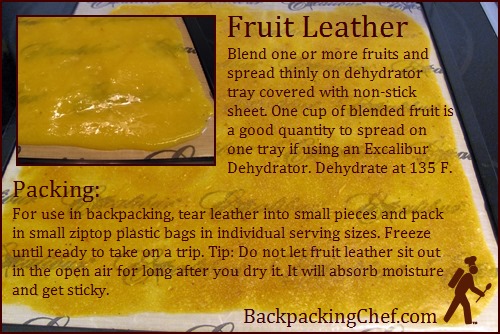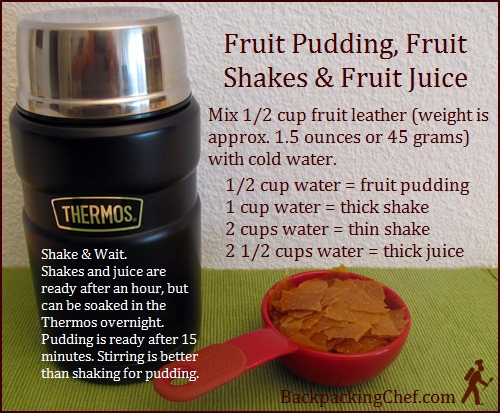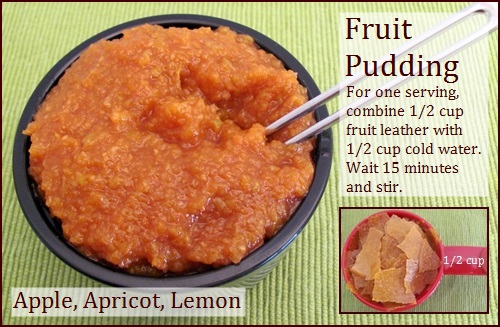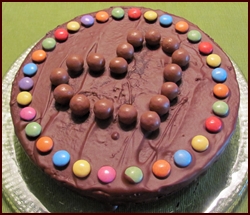| Back to Back Issues Page |
 |
|
July 2015 Trail Bytes: Fruit Pudding, Shakes & Juice July 29, 2015 |
| Hello, On my spring backpacking trip, I cooked hot lunches and made afternoon fruit cocktails using a 24-ounce capacity Thermos Food Jar. See the May newsletter for details. Those two uses made it worthwhile to carry the Thermos which weighed fourteen ounces. Thinking ahead, as long as I am going to carry a Thermos, I want to find more uses for it. For this edition of Trail Bytes, I experimented with fruit leather and came up with two more uses: Fruit pudding for desserts and fruit shakes or juice for breakfast beverages. The order of trail preparation goes like this:
At Home:Whether the intended use is pudding, shake, or juice, start by making fruit leather. Use 100% fruit and nothing else. Put one to three types of raw fruit in the blender and blend it to a smoothie-like consistency. Leave the skins on apples for greater nutrition, but if you plan on diluting the leather to a juice consistency, then peel them first to reduce excessive pulp.Have fun experimenting with your favorite fruits. Ripe fruits taste better than fruits that are not quite ripe, but over-ripe fruit will make your leather very sticky. Similarly, fruits with high sugar content such as pineapple will taste great, but will also increase stickiness. You might want to make pineapple a junior partner in the mix.
After the leather is dry enough to hold together – usually after about six hours – you can peel the leather off the non-stick sheets and flip it over to dry it more thoroughly. With an Excalibur Dehydrator, you can now finish drying the leather on the mesh sheets without the non-stick sheets. Some fruit, such as bananas, may turn a little brown while drying. This is due to oxidation and has little effect on the taste of the finished leather. This week I blended two fruit mixes which I dried on five Excalibur Dehydrator trays:
For more ideas about fruits to blend, see the fruit leather recipes page. Making fruit leather is not an exact science. Have fun with it. Keep a notebook to help you remember what worked best. The nice thing about drying one cup, or slightly more, of blended fruit on one tray is that it yields ½ cup of fruit leather which is a good serving size to make fruit pudding, shakes, or juice. A ½ cup of tightly packed fruit leather will weigh about 1.5 ounces or 45 grams.
Packing Tips:The biggest problem with fruit leather is stickiness. If your leather feels sticky, dry it longer. Since you will rehydrate it rather than eat it as leather, drying it thoroughly is best. Some fruit leather will remain a little sticky no matter how long you dry it.Do not leave fruit leather sitting out in the air after you dry it because it will absorb moisture and get stickier. As soon as it cools, tear it into small pieces and pack in individual servings in snack-size zip top bags. Store in the freezer until ready to pack for a trip. Drying fruit leather thoroughly and packing it immediately will help minimize the problem of fruit leather sticking to itself on the trail. When you vacuum seal backpacking food, the pressure squeezes the fruit leather. If it is well-dried and not too sticky, you can pull it apart without too much trouble.
On the Trail:Whenever possible, use ice cold filtered water from a spring or stream. The Thermos will hold the cold.Fruit Pudding 1 serving Combine ½ cup fruit leather with ½ cup cold water in Thermos or other container. Stir, wait at least fifteen minutes, stir again before serving. This can also be prepared several hours before eating. Thick Fruit Shake 1 serving Combine ½ cup fruit leather with 1 cup cold water in Thermos and shake. Let sit an hour or more. Shake again before serving. Thin Fruit Shake 1 – 2 servings Combine ½ cup fruit leather with 2 cups cold water in Thermos and shake. Let sit an hour or more. Shake again before serving. Thick Juice 1 – 2 servings Combine ½ cup fruit leather with 2½ cups cold water in Thermos and shake. Let sit an hour or overnight. Shake again before serving. The consistency will be like popular nectar-style beverages.
Eating fruit on the trail provides quick energy as well as nutrients and fiber – plus it tastes refreshingly wonderful. A single ½ cup serving of fruit leather (1.5 ounces) equals one pound of fresh fruit – about the same as eating an apple and a banana. Rehydrating fruit leather into pudding, shakes, and juice is a great way to hydrate your body. Dehydrate a wide variety of fruits to add different flavors and colors to your backpacking menu. It’s Worth It! In the May newsletter, I asked if all the time that goes into prepping and drying food was worth it to you. The responses were 100% YES. Here was Jenny’s response: “Hi Glenn, You asked recently in one of your Trail Bytes if all the time spent in the kitchen cooking and dehydrating food for backpacking trips is worth it - and my answer is a definite YES. Even my teenage boys request that I make their meals before trips - the food tastes so much better and is more filling and definitely more nutritious. The food we carry backpacking is not even comparable to the pre-packaged stuff. This is definitely where I want to invest my time and energy. Thank you for providing such great recipes and ideas!” –Jenny
Warmest regards,
Chef Glenn & Dominique P.S. If you have any questions or comments about this issue of Trail Bytes, please reply to this email or use the contact form at BackpackingChef.com. If you received this newsletter from a friend and would like to subscribe (it's free), click here. Visit my Facebook page for the lastest posts.
|
| Back to Back Issues Page |





